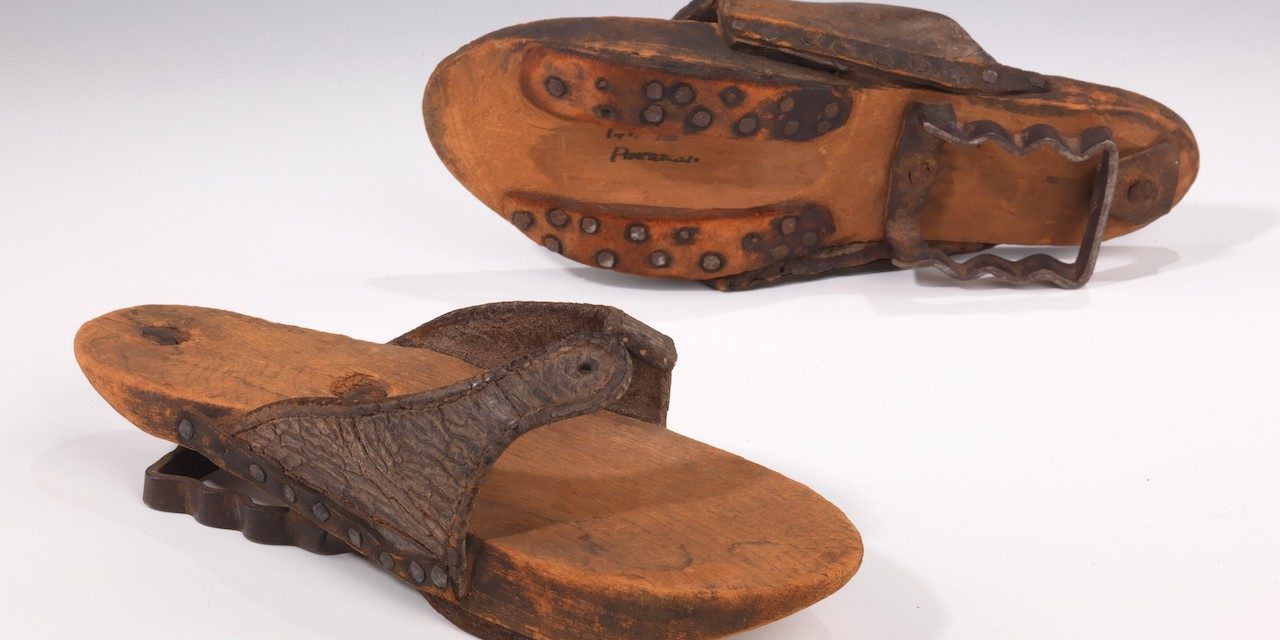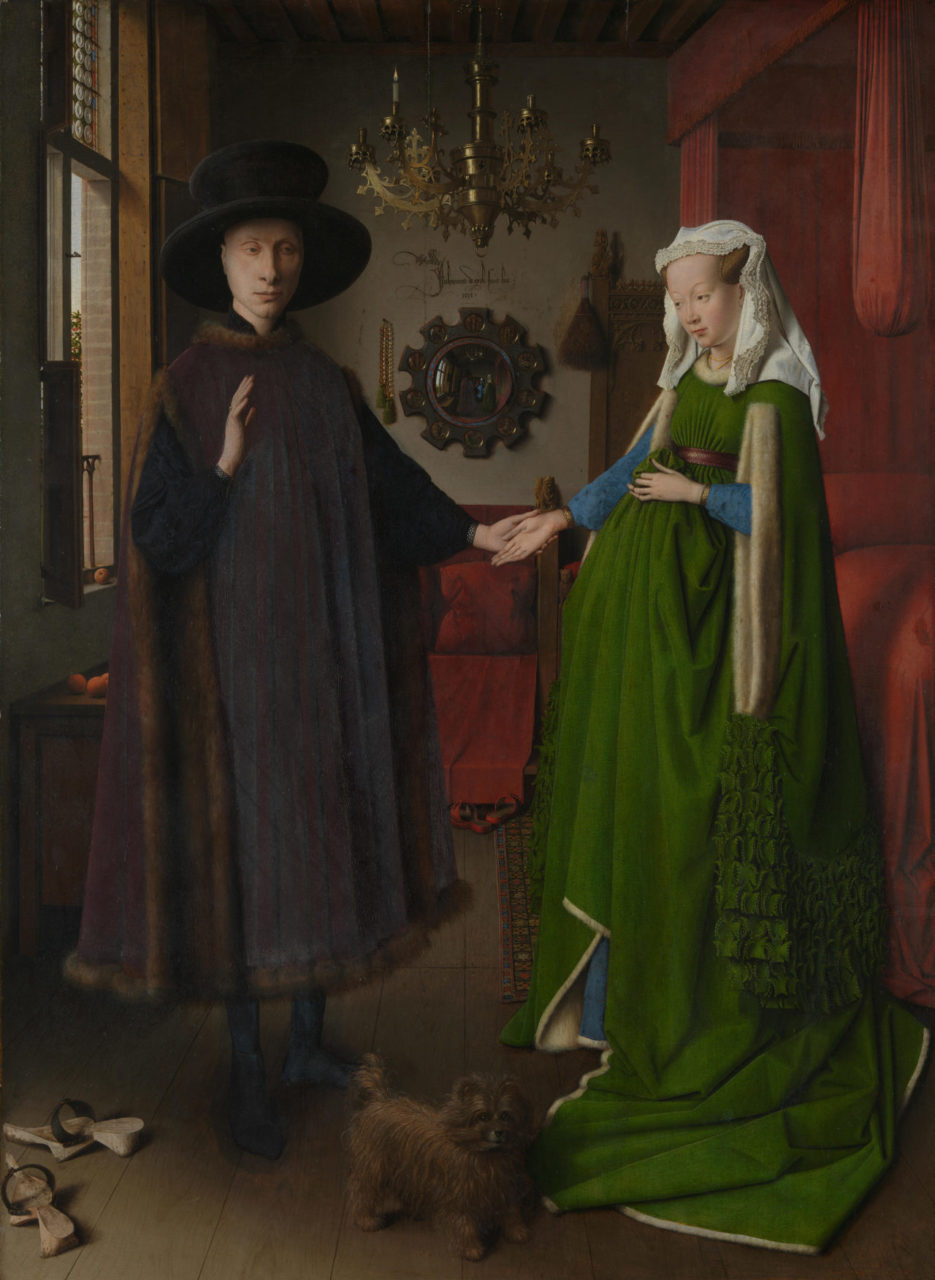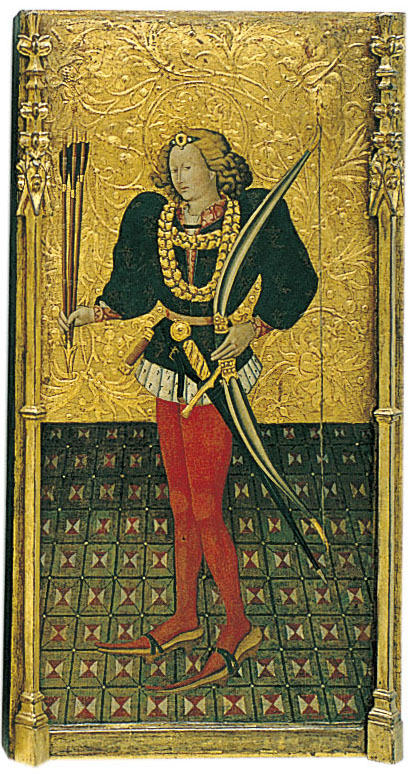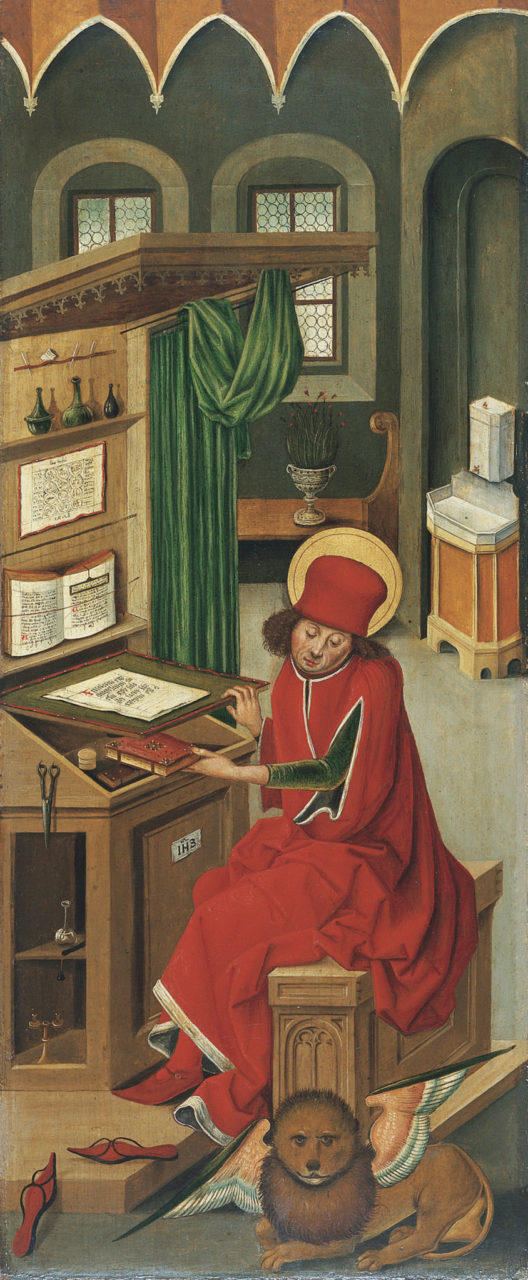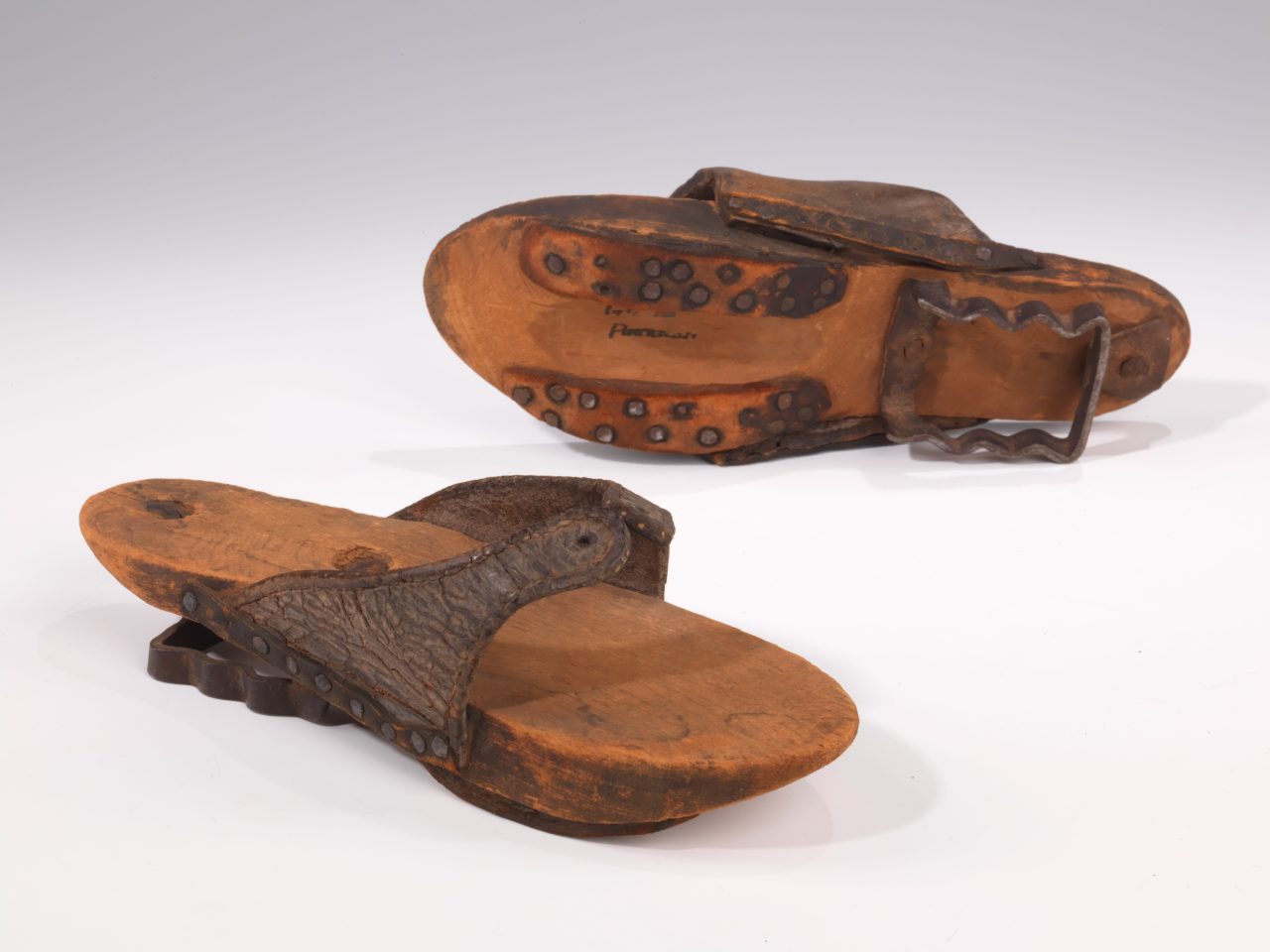Wooden-soled platform over-shoes, which were commonly worn from the 14th century to the 18th century.
The Details
Pattens are defined by Mary Lisa Gavenas in the The Fairchild Encyclopedia of Menswear (2008) as:
“a sort of predecessor of platform shoes, worn from Middle Ages onward, chiefly as overshoes to elevate feet out of the muck and the mud. A typical men’s patten might have a thick wooden sole and attach to the foot with leather straps that resemble a modern sandal.” (120)
The Encyclopedia of Medieval Dress and Textiles of British Isles discusses popular shoe styles, including pattens:
“From 1300-1350 ankle shoes with strap and toggle fasteners were in vogue. Ankle shoes remained the most popular type of footwear and pattens, or overshoes with raised soles became also fashionable at this time.” (Owen-Crocker 322)
Cunnington in Medieval and Tudor Costume (1969) writes that:
“pattens were popular towards the end of the 14th century. They had wooden soles, raised under the heel and toe, and straps to fasten them on over the shoes. People wore them to keep their feet out of the mud.“ (21)
Fig. 1 - Jan van Eyck (Belgian, 1390-1441). The Arnolfini Portrait, 1434. Oil on oak; 82.2 x 60 cm. London: National Gallery, NG 186. Source: The National Gallery
Fig. 2 - Jan van Eyck (Belgian, 1390-1441). The Arnolfini Portrait (detail), 1434. Oil on oak; 82.2 x 60 cm. London: The National Gallery, NG 186. Source: The National Gallery
P
attens are often depicted in artworks, the most significant one being the Portrait of Giovanni Arnolfini and his wife (Fig. 1) by Jan van Eyck. Here we see his (Fig. 2) and hers pairs; his are brown in foreground, while hers are red and in the background. The painting is full of symbolism; even the pattens, here called clogs, are full of meaning, as Gardner’s Art Through the Ages explains:
“Van Eyck depicts the Lucca financier (who had established himself in Bruges as an agent of the Medici family) and his betrothed in a Flemish bedchamber that is simultaneously mundane and charged with the spiritual… Arnolfini and his bride, Giovanna Cenami, hand in hand, take the marriage vows. The cast-aside clogs indicate this event is taking place on holy ground.” (541-42)
Pattens also could be long and pointy to protect fashionable poulaines, as depicted in Jaume Ferrer’s Saint Sebastian, ca. 1450 (Fig. 3). Another type of pattens with thin straps and red sole were depicted by Gabriel Mallesskircher (Fig. 4).
Fig. 3 - Jaume Ferrer (Spanish, d. 1461). Saint Sebatian, ca. 1450. Tempera, stucco reliefs and gold leaf on wood; 144.4 x 76.8 x 13.5 cm. Barcelona, Spain: The Museu Nacional d'Art de Catalunya, 114745-000. Source: The Museu Nacional d'Art de Catalunya
Fig. 4 - Gabriel Mälesskircher (German, 1425-1495). Saint Mark the Evangelist, 1475. Oil on panel; 77.1 x 32.2 cm. Madrid, Spain: Museo Thyssen-Bornemisza, Inv. no. 236 (1928.18). Source: Museo Thyssen-Bornemisza
The Berg Dictionary of Fashion History gives a more comprehensive definition:
“Over-shoes consisting of wooden soles, secured by leather straps and worn with boots or shoes to raise the wearer above the dirt when walking. The shape varied according to the period. Usually for country wear, but very fashionable in the 15th and 18th centuries; until the 17th century the term was synonymous with clogs. From ca. 1630 pattens were raised on iron rings: ‘The women leave in the passage their pattins, that is a kind of wooden shoes which stand on a high iron ring. Into these wooden shoes they thrust their ordinary leather or stuff shoes when they go out.’ (1748, Pehr Kalm’s Account of his Visit to England, Stockholm, 1753. Trans. J. Lucas, 1892) Countrywomen continued to use pattens until the mid-19th century.”
Harte’s “The Economics of Clothing in the Late Seventeenth Century” also notes that pattens by this date have irons rings: “Pattens were wooden soles raised on iron rings to raise the wearer’s shoes above the dirt when walking.” Giorgio Riello described that type, depicted in Figure 5, as the most durably popular. They were often decorated by fabric matching the actual shoe. The pattens were taken off once in the house.
The Metropolitan Museum of Art in New York holds an intact pair of 18th century pattens, supported by iron prongs, yet another type (Fig. 6).
Fig. 5 - Maker unknown (Great Britain). Pair of pattens, 1720s-1730s. Wooden sole, iron ring, and leather latchet fastenings covered with velvet. London, England: Victoria and Albert Museum, T.43&A-1932. Given by Miss F. R. Shipley. Source: Victoria and Albert Museum
Fig. 6 - Maker unknown (American). Pattens, late 18th century. Leather, wood, metal. New York, NY: Metropolitan Museum of Art, 2009.300.1640a, b. Brooklyn Museum Costume Collection at The Metropolitan Museum of Art, Gift of the Brooklyn Museum, 2009; Brooklyn Museum Collection. Source: Metropolitan Museum of Art
References:
- Cumming, Valerie, C. W. Cunnington, and P. E. Cunnington. “Pattens.” The Dictionary of Fashion History. Oxford: Berg Publishers, 2010. 150. Bloomsbury Fashion Central. 18 Sep. 2017. https://www.bloomsburyfashioncentral.com/products/berg-fashion-library/dictionary/the-dictionary-of-fashion-history/pattens.
- Cunnington, Phillis Emily. Medieval and Tudor Costume. Boston: Plays, Inc, 1969. http://www.worldcat.org/oclc/10823.
- Gardner, Helen, and Fred S. Kleiner. Gardner’s Art through the Ages: A Global History. 14th ed. Boston: Wadsworth, Cengage Learning, 2013. http://www.worldcat.org/oclc/932509480.
- Gavenas, Mary Lisa. The Fairchild Encyclopedia of Menswear. New York: Fairchild Publications, Inc, 2008. http://www.worldcat.org/oclc/778077514.
- Harte, N. B., “The Economics of Clothing in the Late Seventeenth Century.” The Berg Fashion Library. (n.d.). http://libproxy.fitsuny.edu:2105/view/CMWF/chapter-FCPS0028.xml (accessed 17 Feb. 2016).
- Owen-Crocker, Gale R., Elizabeth Coatsworth, and Maria Hayward, eds. Encyclopedia of Dress and Textiles in the British Isles c. 450-1450. Boston: Brill, 2012. http://www.worldcat.org/oclc/840039475.
- Riello, Giorgio. “Footwear.” The Berg Fashion Library. http://libproxy.fitsuny.edu:2105/view/bewdf/BEWDF-v8/EDch8068.xml (accessed 10 Mar. 2016).

